| The Johnson Family ~ A Company History |
|
|
|
| The Johnson Family and Photographic Chemicals
by Sidney Ray BSc; MSc; ASIS; HonFBIPP; HonFRPS; FMPA |
||||
| John
Johnson I (JJ-I) born 1737 died July 1786 married Martha Wright |
John Johnson I (JJ-I) qualified as a goldsmith and on July 15th 1762 took a lease on No.7 Maiden Lane in the City of London. He registered as a goldsmith on December 7th 1770 and extended his premises which were leased from the Haberdashers Company. By 1777 JJ-I decided to become an assayer, the first in public practice outside the Royal Mint and assay offices. |
|||
| Eldest son of JJ-I: John Johnson II (JJ-II) born Feb 5th 1765 John Johnson II married Mary Wright (niece of Martha Wright) 1787 JJ-II died in Paris, 1831. |
In 1779 the 14 year old John Johnson II (JJ-II) was taken on as apprentice by his father for the statutory 7 years and was released from this aged 21, coincidentally the year his father died in July 1776. He took over the business and married his cousin Mary Wright in 1787.
|
|||
| Further son of JJ-I: Percival Norton Johnson (1792-1866), left the family business in 1822 and moved to 79 Hatton Garden to set up what became Johnson, Matthey & Co, famous in precious metal dealings and silver recovery, but in strong competition with John Johnson e.g they took over the platinum business. |
||||
|
The eldest son of JJ-II was John Johnson III born 1789 died 1807 aged 18. A further son of JJ-II was named Arthur and he joined the family business with George Johnson. |
son of JJ-II: George Johnson (1807-1872) married Martha Grove (1809-1899) of Huguenot descent |
George Johnson joined the family business in 1829 with brother Arthur and the company became known as Johnson & Sons. George took over the business on the death of his father in 1831. In 1845, Maiden Lane was renamed Gresham Street West (near Wood Street) but the business moved in 1854 to Basinghall Street. Following the gold discoveries in 1848 in California and in 1851 in Australia, London became the principal gold market and consequently in 1852 George Johnson became an Assayer to the Bank of England together with four others including F Claudet, a relative of Antoine Claudet, one of the first professional photographers and of notable pioneering fame in many aspects of photography. |
||
|
Further son of George Johnson was named George, who joined the family business with brother John Grove. Left the business in 1864 but returned in 1882. Two of George's sons entered the business post-1882, joining "Johnson & Sons, Manufacturing Chemists Ltd." |
Eldest son of 5 children of
George Johnson: In 1877 JGJ-I set up residence in Southwood Court, Highgate, until his death, aged 75. He spent 60 years building up a small moribund family business into a flourishing manufacturing and wholesale company with especial regard to the world of photography. He lacked the benefits of inherited wealth and family connections in a time of intense competitiveness in business. He was a quiet, introspective man, a strict disciplinarian, passionately concerned with quality control and innovations in products, an astute business man and philanthropist (from 1890 to 1914 many young girls from the King Edward Street Mission in Spitalfields were employed packing chemicals); the profile of many a successful Victorian entrepreneur. His family life was important and for leisure he painted and played music. |
John Grove Johnson I (JGJ-I) entered the family business in 1849, aided for a time by his brother George who (temporarily) left in 1864, leaving JGJ-I in full control. By this time JGJ-I had, in 1860, also become a liveryman of the Goldsmiths Company. The company was now well established and diversified, being described in a directory of 1865 as "assayers to the Bank of England and Her Majesty's Mint, asayers of bullion, metals, minerals, pigments etc., refiners of platinum, manufacturers of nitrate of silver and other photographic chemicals (wholesale), manufacturers of bullion and other standard weights,chemical apparatus etc. Importers and collectors of minerals and mineralogical specimens". Therein lies a major clue to the future of the business by the mention of photographic chemicals. Silver nitrate had always been a byproduct of the refining of precious metals, and the original use was for surgical cautery (as 'lunar caustic') but the situation had changed dramatically by the 1850s with the invention of the silvering process for glass mirrors (to replace speculum metal) and, much more importantly, the invention of photography. JGJ-I had an intense interest in the latter ! JGJ-I, via his contact F Claudet, supplied the photographers' needs for silver salts, gold salts for toning prints and later developing and fixing agents. The Daguerreotype processes needed silver nitrate and gold chloride, while Fox Talbot's calotype and the wet plate processes needed gallic acid, potassium cyanide and hypo. Beginning a long tradition of the company, many of the chemicals were not actually manufactured by them but purchased cheaply in bulk from elsewhere, refined & repackaged as required. Their great rival, Johnson, Matthey & Co, actually supplied the platinum materials by friendly agreement ! The introduction of dry plates and daylight printing paper (POP) in the 1870s and 1880s necessitated expansion of the business to larger premises. In 1873 they moved to 41 (later 23) Cross Street, Finsbury and to manufacturing premises in Mildmay Avenue, particularly for the refining of antimony. The Cross Street premises were gutted by fire in 1881, but soon rebuilt to designs of George Sherrin, much acclaimed at the time, and in 1884 were lit by the then novel electric light. The first floor was devoted to the manufacture of gold chloride, much in demand for the toning of the POP materials invented by Sir William Abney. It was marketed in 15 grain glass tubes as the stable double salt with sodium chloride. By the latter 1880s the company
was firmly established as a leading independent house for the
supply of a range of photographic goods and for the rapid supply
of new goods as the technology of photography progressed. Apart
from his close contacts with Claudet and his successors, JGJ-I
also had a cousin, William Grove who, from 1870, was a partner
in Window & Grove, a well known West End
firm of photographic portrait studios. William also served as
a director in the Johnson companies. |
||
| Another son of JGJ-I, Ronald, was killed in an accident at work. |
Elder son of JGJ-I, Sister Edith ran the business as Chairman from 1908 to 1922. |
Of JGJ-I's two sons in the business, Ronald was killed in an accident at work and the other, John Grove Johnson II (JGJ-II), who entered the business in 1886, 'retired' after the death of his father in 1908. A nephew of JGJ-I, John Frederick Johnson, also worked there, but only for a short time. JGJ-II's sister Edith Johnson successfully took up his responsibilities for the next 14 years, an interesting early example of a woman being Chairman of an important group of companies. JGJ-I was presumably aware that JGJ-II was likely to leave the family business and became concerned about the business' future. Hence, in 1882 he split off the chemical manufacturing and marketing division as Johnson & Sons Manufacturing Chemists Ltd, with the welcome return of his brother George (who had left in 1864). Two of George's many sons entered the business, giving continuity. |
||
|
By the end of the 19th Century nepotism was on the wane and new blood entered the business. In 1898, John Wenham, a former factory manager of Pilkingtons, became manager and in 1900 and 1901 the melting and assay departments were incorporated into separate companies as Johnson & Sons Smelting Works Ltd and Johnson & Sons (Assayers) Ltd. In 1902, Wenham introduced E Bernard Cook to the business (when his father purchased a block of shares!) to succeed him. Bernard Cook became Chairman (1922-49) and President (1949 until his death 4th June 1965) of the company. A portrait of E.B.Cook by Arthur Fuller was commissioned for the Festival of Britain in 1951 as one of the country's leading businessmen. Note: Sidney Ray originally gave the date of Bernard Cook becoming President of Johnsons as 1959, but subsequent information suggests this may more correctly be 1949. The Johnson & Sons Smelting Works Ltd continued successfully until the outbreak of war in 1914 when supplies of bullion became erratic and so the Works diversified into copper refining. Post war, South Africa decided to send no more bullion to the UK for refining, so the Works relocated to Brimsdown as copper smelters and precious scrap dealers. Johnson & Sons (Assayers) Ltd suffered similar fortunes. In the industrial slump of the 1920s (1926) they both found it best to be absorbed by their long time rivals Johnson, Matthey & Co. Johnson & Sons Manufacturing Chemists Ltd flourished in 1900-14 with the manufacture and packaging of ready-for-use developers and other reagents. The sale of gold chloride in 15 grain glass tubes with the trademark of the Scales Brand occurred world-wide. Bernard Cook became acting managing director in 1910 and by 1913 it was obvious a new site was needed, especially for packaging amateur photographic chemicals. A freehold site in rural Hendon in North London was chosen but war in 1914 meant that a packaging plant was not built. Instead a new plant was built to manufacture the developing agent amidol (diamidophenol) when supplies from the vast chemical industries of Germany, based on coal tar derivatives, promptly ceased on start of hostilities. The later exponential growth of photography for war purposes (principally aerial photography), followed by radiography and the cinema, produced an increasing demand for photographic chemicals. New buildings on the Hendon site were constructed for the manufacture of metol, hydroquinone, paramidophenol, glycin and pyrogallic acid as well as some pharmaceuticals. This was the establishment of a key industry in all senses. In 1927, when the lease on the Cross Street premises expired, everything was moved to the Hendon site with Bernard Cook now as chief executive. In 1948 the name of the company was finally changed to Johnsons of Hendon Ltd, the name by which it had become known throughout the photographic and chemical trades. Family history relating
to Elizabeth Barnicott,
who married John Grove Johnson, has come to me from Sandra Robinson,
a descendent of Elzabeth Barnicott. She writes: |
|
|
Reference: McDonald D (1964).
"The Johnsons of Maiden Lane" Martins Publishers Ltd,
London. 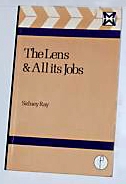 At the time of writing
the above article, Sidney Ray was Senior lecturer in Photographic
and Electronic Imaging Sciences at the University of Westminster.
He worked as a Photographic Chemist for Johnsons of Hendon from
1960-66 at the Hendon site, carrying out R&D, plant supervision,
quality control, general photography and technical services.
When Sidney left Johnsons in 1966, 'Pip' Pippard took over in the role of Chief
Chemist. Amongst
his many contributions to photography, Sidney assisted with authoring
the year 2000 edition of Focal Press book 'The Manual of Photography'
(previously 'The
Ilford Manual of Photography'). At the time of writing
the above article, Sidney Ray was Senior lecturer in Photographic
and Electronic Imaging Sciences at the University of Westminster.
He worked as a Photographic Chemist for Johnsons of Hendon from
1960-66 at the Hendon site, carrying out R&D, plant supervision,
quality control, general photography and technical services.
When Sidney left Johnsons in 1966, 'Pip' Pippard took over in the role of Chief
Chemist. Amongst
his many contributions to photography, Sidney assisted with authoring
the year 2000 edition of Focal Press book 'The Manual of Photography'
(previously 'The
Ilford Manual of Photography').
During (at least) the early 1980s,
Sidney contributed technical articles to 'Photography' magazine
(e.g. "CAMERAS inside and out; How They Work", April 1981,
pages 39-41) and also occasionally answered readers questions. |
|
| The history of the photographic process, as begun in France by Louis Daguerre and in England by Fox Talbot, was narrated in the Johnsons advertisment pages within the British Journal Photographic Almanac (BJPA) for 1945 (pages 36, 37, 38 and 39). It includss other details but essentially confirms the Johnsons family history as above. | |
| Aerial site view of Johnsons of Hendon in the BJPA for 1950 | Opening page to Johnson & Sons of Hendon advertisment in the BJPA for 1945. |
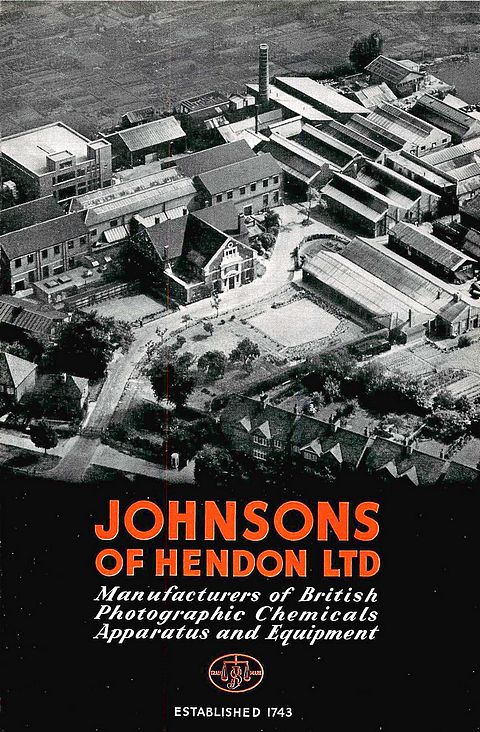 |
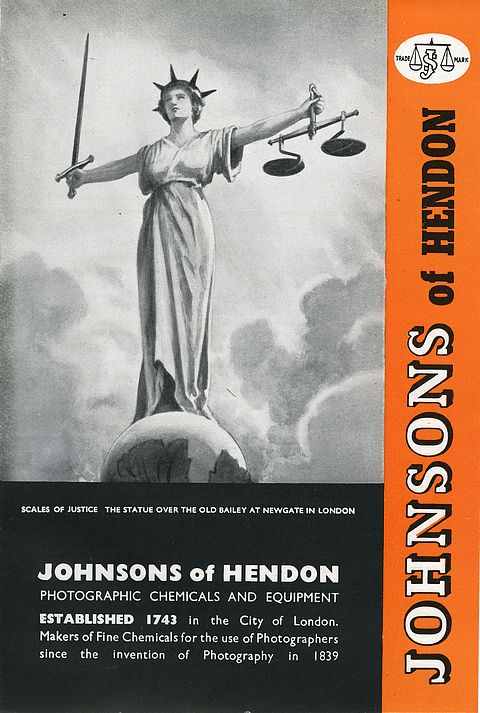 |
 |
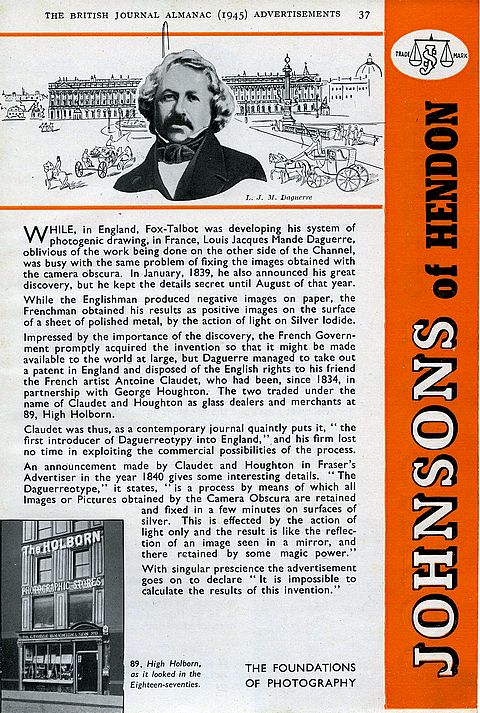 |
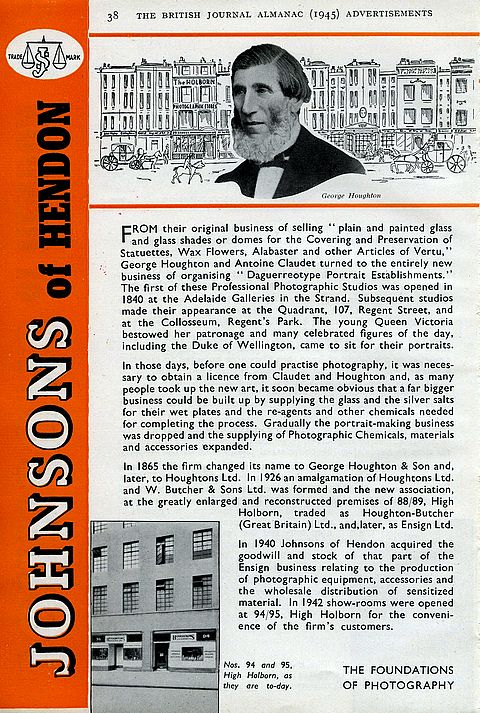 |
 |
|
|
|
|
|
|